NIF & PS People - 2014
October
High-Foot Team Receives NNSA Defense Programs Award of Excellence
Don Cook, deputy administrator for Defense Programs at the National Nuclear Security Administration (NNSA), presented a NNSA Defense Programs Award of Excellence on Oct. 31 to the team that developed and conducted the high-foot experiments on NIF that produced record energy yields in Fiscal Year 2014.
The High-Foot team was cited for “developing and demonstrating on NIF an indirectly driven three-shock high-foot implosion that is significantly more robust against ablator driven instability growth in order to obtain better implosion control.” The experiments showed an order-of-magnitude improvement in yield performance over previous NIF shots as well as a significant contribution to the yield from alpha-particle self-heating, in which the alpha particles (helium nuclei) produced in the deuterium-tritium (DT) fusion process deposit their energy in the DT fuel. The alpha particles further heat the fuel, increasing the rate of fusion reactions, thus producing more alpha particles. This “bootstrapping” process is the mechanism required to accelerate the DT fusion burn rate to eventual self-sustaining fusion burn and ignition.
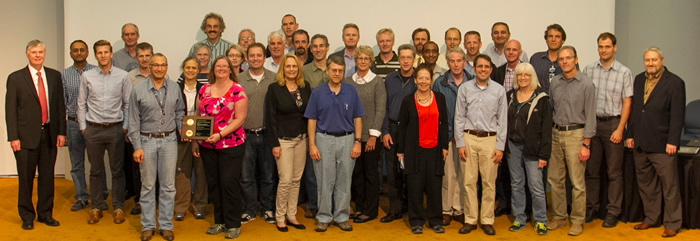 NNSA’s Don Cook (left) and LLNL Director Bill Goldstein (right) with members of the High-Foot Team.
NNSA’s Don Cook (left) and LLNL Director Bill Goldstein (right) with members of the High-Foot Team. The high-foot experiments feature a higher initial laser pulse than previous “low-foot” shots, shorter pulse duration, and three laser shocks on the target rather than four. This configuration is designed to reduce ablation-front instability growth and thereby inhibit ablator material from mixing into and contaminating the DT hot spot (see Controlling Hydrodynamic Mixing in NIF Implosions). The essential stability benefits of the high-foot scheme can be seen in a reduction in the linear growth rate of ablation-driven Rayleigh-Taylor hydrodynamic instability.
“Alpha heating and ignition are very high visibility goals for LLNL,” the Award of Excellence citation said. “The High-Foot Team directly tested the degree of ablation front stabilization gained from the high-foot pulse shape using face-on radiography experiments. In this campaign, record DT fusion yields and significant alpha-particle self-heating have been achieved. The implosions also show low levels of inferred mix and show excellent agreement with one- and two-dimensional implosion models without the aid of mix models.”
The Defense Programs Award of Excellence was established to recognize the contributions of the work performed in support of the NNSA Stockpile Stewardship Program. It’s designed to recognize significant achievements in quality, productivity, cost savings, safety or creativity in support of the nuclear weapons program.
Team members include Omar Hurricane, David Bradley, Debra Callahan, Daniel Casey, Eddie Dewald, Tom Dittrich, Tilo Döppner, Maria Barrios Garcia, Denise Hinkel, Laura Berzak Hopkins, Peggy Kervin, Sebastien Le Pape, Tammy Ma, Andrew MacPhee, Jose Milovich, John Moody, Art Pak, Prav Patel, Hye-Sook Park, Bruce Remington, Harry Robey, Jay Salmonson, Paul Springer, RicardoTommasini, Laura Robin Benedetti, Richard Bionta, Joseph Caggiano, William Cassata, Peter Celliers, Charlie Cerjan, Jennifer Church, Daniel Clark, Laurent Divol, Mark Eckart, David Fittinghoff, John Field, Nobuhiko Izumi, Narek Gharibyan, Steve Haan, Bruce Hammel, Robert Hatarik, Oggie Jones, Shahab Khan, Bob Kirkwood, Andrea Kritcher, Steve MacLaren, Pierre Michel, Sabrina Nagel, Luc Peterson, Joseph Ralph, Kumar Raman, Mordy Rosen, Steve Ross, Ryan Rygg, Dan Sayre, Marilyn Schneider, Dawn Shaughnessy, Wolfgang Stoeffl, Brian Spears, Vladimir Smalyuk, David Strozzi, Cliff Thomas, Carol Velsko, Chris Weber, Klaus Widmann, Charles Yeamans, Andrew Mackinnon, Richard Town, Nathan Meezan, Mehul Patel, Scott Sepke, Howard Scott, Marty Marinak, Brian Pudliner, Dan Klem, Perry Bell, Alex Hamza, Chris Choate, Denise Hoover, Ethan Alger, Lynn Kot, Bob Burr, Kai LaFortune, Brian MacGowan, Dan Kalantar, Gayatri Gururangan, Pascale Di Nicola, Reg Wood, Steve Weaver, Simon Cohen, Bernie Merritt, Tom Kohut, Nick Jize, Chuck Ellerbee, Bernie Kozioziemski, Tom Parham, Ken Kasper, Greg Tietbohl, Gordon Brunton, Allan Casey, Pam Whitman, Ruth Hawley and Jim Folta.
Ice Bucket Challenge Launches 2014 HOME Campaign
LLNL’s 2014 HOME (Helping Others More Effectively) charitable giving campaign, sponsored this year by the NIF & Photon Science Directorate, kicked off on Oct. 30 with a splash.
Jeff Wisoff, principal associate director for NIF&PS, and Bruce Warner, principal associate director for Global Security, started the traditional HOME Run around the Lab with an ice bucket challenge. “The ice bucket challenge originally started as a fundraising effort to help raise awareness for ALS (better known as Lou Gehrig’'s disease),” said Warner. “Today Jeff and I are challenging all of you to donate to your favorite charity. Even a dollar goes a long way.”
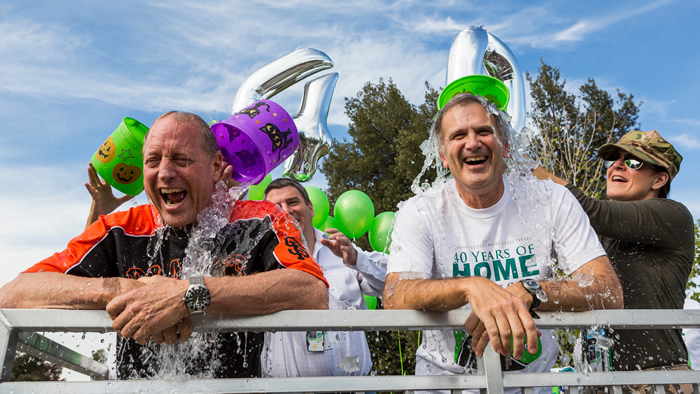 Bruce Warner (left) and Jeff Wisoff take the ice bucket challenge to launch the 2014 Home Run.
Bruce Warner (left) and Jeff Wisoff take the ice bucket challenge to launch the 2014 Home Run. Now in its 40th year, the HOME Campaign allows employees to donate money to their favorite charities through payroll deductions or by check. With the theme of “Decades of Giving,” this year’s campaign will run until Dec. 5. Lawrence Livermore National Security, LLC (LLNS) has again pledged to match employee donations up to $1 million. If the campaign exceeds that amount in donations, the matching funds will be pro-rated. The campaign’s goal is to raise $2.3 million in donations.
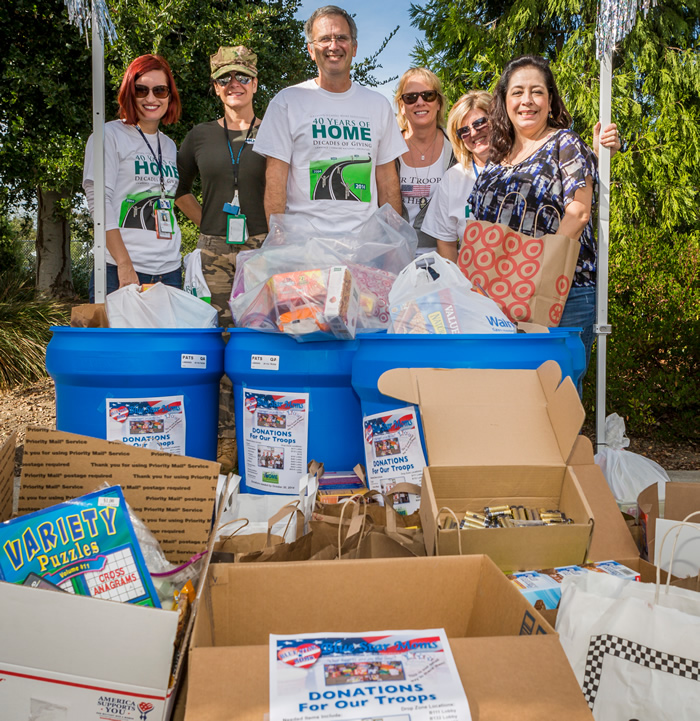 Employees donated Halloween candy and other items to be boxed up and sent to U. S. troops serving overseas as part of Operation Gratitude’s 2014 Halloween Candy for the Troops Program.
Employees donated Halloween candy and other items to be boxed up and sent to U. S. troops serving overseas as part of Operation Gratitude’s 2014 Halloween Candy for the Troops Program. “The HOME campaign opened today and employees have already pledged more than $100k,” Wisoff said. “We have invested generously in our community over the past 40 years and we encourage everyone to continue that tradition to get involved, as every dollar counts.”
NIF&PS Teams Receive LLNL S&T and Publications Awards
Three teams led by the NIF & Photon Science Directorate received 2014 Science & Technology Awards, and two teams received Publication Awards, from Laboratory Director Bill Goldstein in a ceremony on Oct. 22. The awards went to five LLNL-led project teams, conference presenters and journal authors and individuals for their exceptional endeavors in science and technology.
The Director’s S&T Awards Program was first implemented in 2000 to acknowledge, celebrate and reward recent significant scientific and technical accomplishments by research teams.
2014 Director’s S&T Awards

The solid radiochemistry and radiochemical analysis of gaseous species diagnostics team developed and operates NIF’s Radiochemical Analysis of Gaseous Samples (RAGS) diagnostic. Developed for NIF by Sandia National Laboratories and commissioned in 2012, RAGS is a cryogenic system designed to collect the gaseous debris from the NIF target chamber after a laser shot, then concentrate, purify and analyze the debris for radioactive gas products.
Radiation detectors on the apparatus produce rapid, real-time measurements of the radioactivity content of the gas. Based on the results of the radiation counting, the total number of radioactive atoms that were produced via nuclear reactions during a NIF shot can be determined.
Team members are Bryan Bandong, Lee Bernstein, Joseph Caggiano, Dan Casey, William Cassata, Charlie Cerjan, John Despotopulos, Narek Gharibyan, Anatoly Golod, Patrick Grant, Christian Hagmann, Martin Hoppe, Don Jedlovec, Kenn Knittel, Kenton Moody, Hye-Sook Park, Prav Patel, Allen Riddle, Scott Sepke, Dawn Shaughnessy, Wolfgang Stoeffl, Bahram Talison, Philip Torretto, Carol Velsko, Paul Wooddy and Charles Yeamans.

Ramp compression of diamond to five terapascals: Laboratory scientists and their colleagues have, for the first time, experimentally recreated the conditions that exist deep inside giant planets, including many of the planets recently discovered outside our solar system. The team squeezed samples to 50 million times Earth’s atmospheric pressure, comparable to the pressures at the center of Jupiter and Saturn.
Team members are Lorin Benedict, Donald Bennett, Juergen Biener, David Braun, Tom Braun, Peter Celliers, Rip Collins, Phil Datte, Tom Duffy, Jon Eggert, Dayne Fratanduono, Gene Frieders, Sebastian Hamel, Alex Hamza, Damien Hicks, Raymond Jeanloz, Daniel Kalantar, Kerry Krauter, Kai Lafortune, Amy Lazicki, Steve Little, Marius Millot, Walter Nederbragt, Jeremy Patterson, Gary Ross, Robert Rudd, Marilyn Schneider, Raymond Smith, Jue Wang, Morris Wang, Klaus Widmann and Christoph Wild. 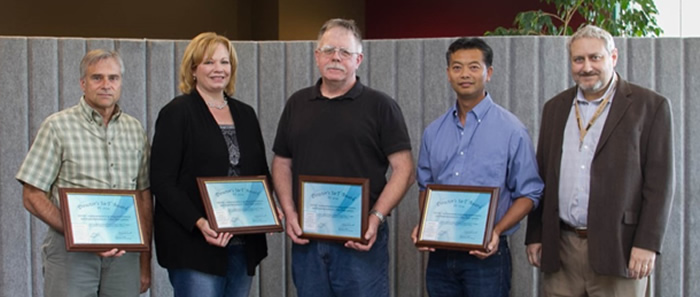
Improvements in grating performance and implementation in a fiber laser system: An optical technology developed by LLNL scientists and two industrial partners allows the beams from many small lasers to be combined to produce a single higher-power beam with unprecedented beam quality and electrical efficiency.
Called “Extreme-power, Ultra-low-loss, Dispersive Element (EXUDE),” the technique enables the separate wavelengths of the smaller lasers to be superimposed into an electrically efficient, single-output laser system.
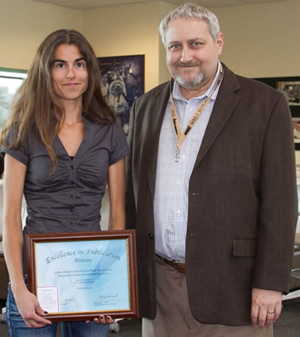 Federica Coppari with LLNL Director Bill Goldstein and her Postdoc Excellence in Publication Award for her paper, “Experimental evidence for a phase transition in magnesium oxide at exoplanet pressures” (Nature Geoscience 6, 926-929 (2013)). The research was conducted on the OMEGA Laser Facility at the University of Rochester.
Federica Coppari with LLNL Director Bill Goldstein and her Postdoc Excellence in Publication Award for her paper, “Experimental evidence for a phase transition in magnesium oxide at exoplanet pressures” (Nature Geoscience 6, 926-929 (2013)). The research was conducted on the OMEGA Laser Facility at the University of Rochester. Team members are Michael Aasen, Jerry Britten, Thomas Carlson, Curly Hoaglan, Cindy Larson, Hoang Nguyen and James Nissen.
2014 Director’s Excellence in Publication Awards
Basic Science: “Measurement of the T+T Neutron Spectrum Using the National Ignition Facility,” Physical Review Letters, vol. 111, 052501 (2013). Daniel Sayre, Carl Brune, Joseph Caggiano, Vladimir Glebov, Robert Hatarik, Andrew Bacher, Darren Bleuel, Dan Casey, Charlie Cerjan, Mark Eckart, Richard Fortner, Johan Frenje, Stephan Friedrich, Maria Gatu-Johnson, Gary Grim, Chris Hagmann, James Knauer, John Kline, Dennis McNabb, James McNaney, Mark Mintz, M. J. Moran, Abbas Nikroo, Thomas Phillips, Jesse Pino, Bruce Remington, Dana Rowley, Dieter Schneider, Vladimir Smalyuk, Wolfgang Stoeffl, Robert Tipton, Steve Weber and Charles Yeamans.
Applied Science: “Onset of Hydrodynamic Mix in High-Velocity, Highly Compressed Inertial Confinement Fusion Implosions,” Physical Review Letters, vol. 111, 085004 (2013). Tammy Ma, Prav Patel, Nobuhiko Izumi, Paul Springer, Mike Key, Jeff Atherton, Robin Benedetti, David Bradley, Debbie Callahan, Peter Celliers, Charlie Cerjan, Dan Clark, Eduard Dewald, Sham Dixit, Tilo Döppner, Dana Edgell, Ruben Epstein, Steven Glenn, Gary Grim, Steve Haan, Bruce Hammel, Damien Hicks, Warren Hsing, Oggie Jones, Shahab Khan, Joe Kilkenny, John Kline, George Kyrala, Nino Landen, Sebastien Le Pape, Brian MacGowan, Andrew Mackinnon, Andrew MacPhee, Nathan Meezan, John Moody, Arthur Pak, Tom Parham, Hye-Sook Park, Joseph Ralph, Sean Regan, Bruce Remington, Harry Robey, Steven Ross, Brian Spears, Vladimir Smalyuk, Lawrence Suter, Riccardo Tommasini, Richard Town, Steven Weber, John Lindl, John Edwards, Siegfried Glenzer and Ed Moses.
Mark Herrmann Named NIF Director
Mark Herrmann of Sandia National Laboratories assumed the position of NIF Director on Oct. 6, replacing Jeff Atherton, who was named Principal Deputy for the NIF & Photon Science Principal Associate Directorate (PAD) in June.
As the NIF Director, Herrmann will work closely with the leadership of the National Nuclear Security Administration’s Stockpile Stewardship Program (SSP) across the weapons complex including the national Inertial Confinement Fusion (ICF) Program, as well as the National Security Applications and Discovery Science communities in the United States and globally, to ensure optimal use of the facility and delivery on program goals. He will have line management responsibility for the operations, facility use plan, and activities of NIF and will develop a strategic plan for the long-term future of the facility.
Reporting to the NIF&PS Principal Associate Director, the NIF Director is a key member of the directorate’s senior leadership team supporting the strategic goals of the PAD and the Laboratory.
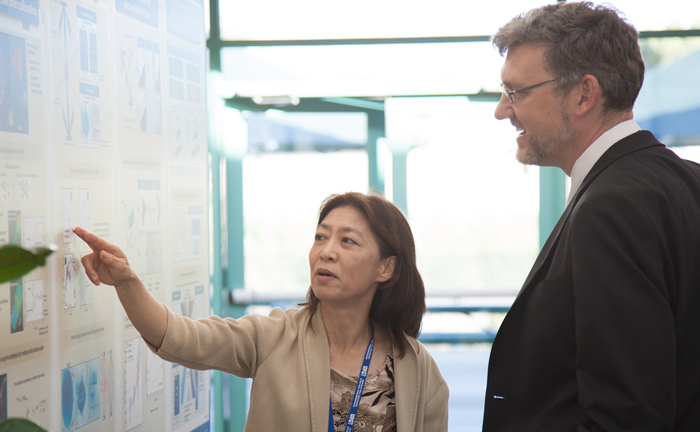 NIF&PS physicist Hye-Sook Park discusses NIF Discovery Science research with Mark Herrmann during a poster session following a meeting of the NIF Management Advisory Council in June.
NIF&PS physicist Hye-Sook Park discusses NIF Discovery Science research with Mark Herrmann during a poster session following a meeting of the NIF Management Advisory Council in June. “Mark brings a wealth of knowledge and experience to this position and has played a recognized leadership role in national efforts to help shape the future of high energy density (HED) science,” said NIF&PS Principal Associate Director Jeff Wisoff. “He has worked closely with all three laboratories (LLNL, Los Alamos, and Sandia) as well as our NNSA (National Nuclear Security Administration) stakeholders.”
Herrmann has held several key leadership and management roles in the Pulsed Power Sciences Center at Sandia, including director of the Center, senior manager of the HED Science and Radiation and Fusion Physics groups, and manager of the ICF Target Design Department. Under his leadership, Sandia’s Z Facility has delivered key results for the SSP program that have been widely recognized throughout the NNSA complex and by external stakeholders.
After obtaining a Ph.D. in plasma physics from Princeton University, Herrmann began his career at LLNL as postdoc in 1998, and then became a staff physicist in AX division. He is a Fellow of the American Physical Society and has been recognized with the Presidential Early Career Award for Scientists and Engineers and the Fusion Power Associates Excellence in Fusion Engineering award.
“We look forward to Mark’s return to LLNL,” Wisoff said. “I would also like to thank Jeff Atherton for his service as NIF Director. He has been instrumental in bringing the HED community together and establishing governance processes that have set the course for NIF as a National User Facility. I look forward to continuing to work with him in his capacity as the Principal Deputy for NIF&PS.”
Laser Roadshow Featured at Boy Scout STEM Encampment
The NIF&PS Laser Roadshow completed another successful outreach event at a Boy Scout STEM (Science, Technology, Engineering, and Mathematics) Encampment at the Alameda County Fairgrounds in Pleasanton on Oct. 11.
The Boy Scouts of America is incorporating elements of STEM in its advancement programs, giving scouts an opportunity to explore relevant skills and experiences and have their achievements recognized through STEM “NOVA” and “Supernova” awards. Working with an adult counselor or mentor, scouts can explore the basic principles of STEM and discover how fun and fascinating STEM can be.
Mark Martinez, LLNL’s principal associate director for operations and business, was honorary chairman of the encampment, and Tammy Jernigan, the Lab’s assistant associate director for physics and advanced technologies, was a women’s luncheon speaker. The NIF&PS laser roadshow volunteers were Mike Rushford, Reggie Drachenberg, Laura Berzak Hopkins, Roger Qiu, Zhi Liao, John Crane, Tim Frazier, and John Post.
 Laura Berzak Hopkins and Roger Qiu operate a laser light fountain to demonstrate the optics principle of total internal reflection in the NIF booth at the Boy Scout STEM Encampment.
Laura Berzak Hopkins and Roger Qiu operate a laser light fountain to demonstrate the optics principle of total internal reflection in the NIF booth at the Boy Scout STEM Encampment. NIF’s “Formula One” Model Receives Operational Excellence Award
Formula One race-car pit crews are noted for their speed and efficiency in getting their cars back on the track after a pit stop. An operations model based on the Formula One pit-crew model was developed by the NIF Team in 2014 to improve shot turnaround efficiency and enable a new scheduling paradigm. The model’s success recently was recognized by LLNL Director Bill Goldstein with the presentation of a 2014 Director’s Institutional Operational Excellence Award.
The award recognizes extraordinary team efforts that have an institutional impact, demonstrate cost savings and improve Laboratory programs and operations. The NIF Team’s goal was to optimize shot processes to minimize reconfiguration times between shots by having the right people, doing the right things, with the right parts in the right place at the right time, leading to improvements in safety, quality and efficiency.
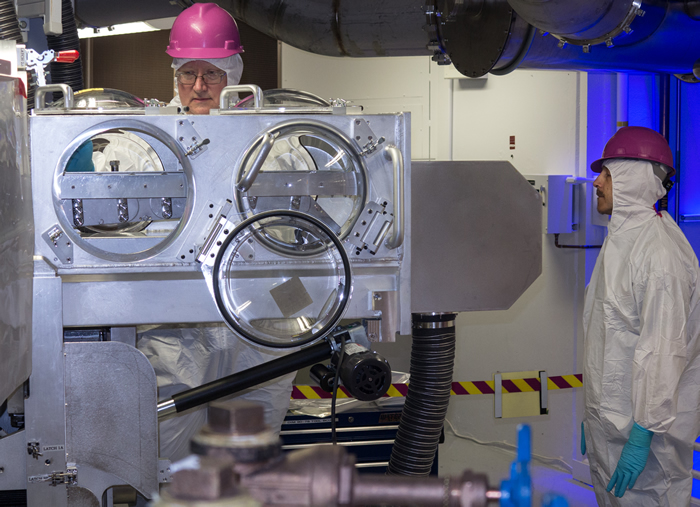 Target area operators Steve Keesee and Chris Cashin monitor the removal of the Hardened Gated X-ray Diagnostic HGXD2 cart cable tray from a diagnostic instrument manipulator after completion of an experiment during a recent high-tempo week in which six cryogenic shots were fired in 75 hours. The cart was replaced by the HGXD3 cart for the next shot in the series, all part of the fast-paced Formula One program.
Target area operators Steve Keesee and Chris Cashin monitor the removal of the Hardened Gated X-ray Diagnostic HGXD2 cart cable tray from a diagnostic instrument manipulator after completion of an experiment during a recent high-tempo week in which six cryogenic shots were fired in 75 hours. The cart was replaced by the HGXD3 cart for the next shot in the series, all part of the fast-paced Formula One program. A working group was formed to identify operational changes that would result in everything being in place for shot N+1 while shot N was taking place. Changes included planning shots to minimize reconfigurations, staging parts closer to point of use, staging components by shot ID, development of checklists for post-shot recovery and reconfiguration, mustering of teams at designated locations immediately following a shot, and revision of radiological work permits to eliminate unnecessary controls. This efficient approach required a significant departure from the existing process.
Implementation of the NIF Formula One Operations Model was a significant operational improvement toward increasing the shot rate at NIF (see Operational Improvements Boost NIF’s Productivity).
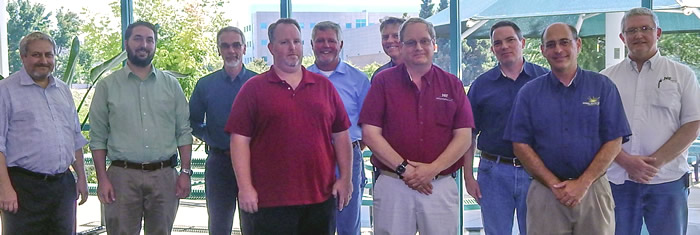 LLNL Director Bill Goldstein (left) with Formula One Team members Adam Langro, Chris Wlodarczyk, Chuck Ellerbee, Jim Cox, Kenneth Kasper, Mark Wilson, Richard Beale, Robert Ehrlich and Tom Kohut.
LLNL Director Bill Goldstein (left) with Formula One Team members Adam Langro, Chris Wlodarczyk, Chuck Ellerbee, Jim Cox, Kenneth Kasper, Mark Wilson, Richard Beale, Robert Ehrlich and Tom Kohut. 


